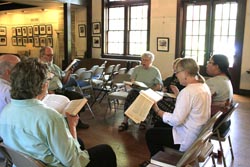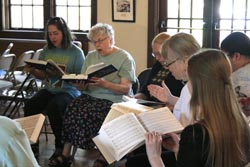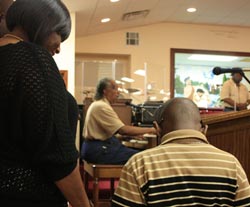Sacred Sounds in Baton Rouge Churches, Synagogues, Temples, and Mosques
By Maureen Loughran

Group Singing: Shape Note Singers and Gospel Quartets
While choirs are typical of many churches in Baton Rouge, there are other kinds of ensembles in which the performance of the music has different functions. In one, Sacred Harp singing, the material has spiritual and religious origins, but the use is not religious. Instead, singing is a tool for building a secular community, one based on love of music. In another, the gospel quartet mirrors the function of the gospel choir, but it is condensed to a small group of voices, still powerfully connecting their worship to that of their church's appreciative membership.
The Baton Rouge Shape Note Singers
On the fourth Sunday of nearly every month, a group of singers gathers at the St. Albans Chapel on the Louisiana State University campus to sing old hymns in the Shape Note tradition. The style of singing gets its name from the fact that like the hymnal found at Goodwood Church of Christ, the hymns are written in a musical notation of shapes, triangles, squares, and circles. While the hymns are certainly sacred in their content, the context of the singing is secular. The gathering of singers is strictly for the love of the music.
A singing session starts with the room set up in a square. The chairs are placed in rows along the four sides of a square, each side denoting a singing section: treble, alto, tenor, and bass. The center of the square is left empty, and thereby giving the name to the room set-up as the hollow square. Sometimes, a song leader will stand in the center of the square in order to conduct the singing, facing different sections as the song progresses and keeping steady time with their arm. Members choose which songs they will sing during the course of the afternoon, with favorite songs being led by those who choose the song, or by an appointed leader. The song first is sung in "shapes," meaning instead of singing the lyrics, the singers use a system of syllables, one for each note in the scale, called solfege that corresponds to the shapes on the staff. For example a note with a triangle shape would be sung as "fa", a circle as "sol," a square as "la," and diamond shape as "mi." This helps remind the singers of the melody before singing the song proper. Once through a verse with the shapes, the singers sing the next round with the lyrics, often singing all the verses of the song to the end. After several songs, the group might take a break for coffee and visit with friends, before starting again. At the gathering at LSU, two large songbooks are used: a blue book, known as the Cooper edition and a brown book, known as "The Sacred Harp." Both contain many of the same songs, but arrangements may vary, depending on the volumes editor. Occasionally, singers will ask to review their specific part for a song, but often singers learn their parts by listening to their neighbors. Singing loudly, as a result, is highly encouraged!
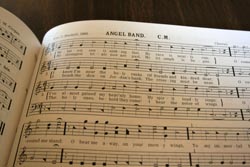
The group in Baton Rouge is relatively new, founded in 2010 as a result of several musical acquaintances wanting to start a singing session like those they had participated in elsewhere in the South. The Sacred Harp tradition of singing is well-known as a religious tradition in parts of Alabama and Georgia, but it is less well-known as a tradition, sacred or secular, in Southern Louisiana. Two of the founders of the Baton Rouge Sacred Harp singers shared their motivations for starting the group. Nanette Olivier is a native of Louisiana, but did not grow up in the Sacred Harp tradition. Neither did the group's co-founder Charlene Heaton, who is a native of Pennsylvania and encountered the tradition of sacred harp while living in Missouri. Both women are first and foremost interested in the singing, the music notation, the old poetry, the musical settings and the community that is created at singing sessions. And while the sessions are secular, they can have spiritual aspects for individual singers. Nanette commented on this:
There's something about referencing this text that others across churches and traditions and belief systems that come together and speak those words and with the melodies and harmonies is just so uplifting and centering, and it's kind of a spiritual experience. For me it is. I think it's the history of everyone who has proceeded you in singing in this tradition, there's something about it. (Olivier and Heaton 2016)
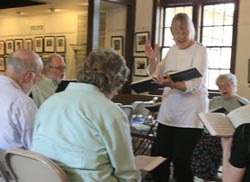
History is very present in these old hymns, several of which have authorship that dates to the 18th century. For example, "Africa," is a well-known shape note song written by American choral composer William Billings sometime in the late 1700s. Billings wrote music to verse by the hymnodist Isaac Watts to create this piece that is still sung by Sacred Harp groups today. In fact, Charlene pointed it out as one of her favorite songs to sing because of how poetically Isaac Watts poses theological questions in the verse:
I love when the text has little surprises in it or really nice language. Like "Africa" I really love because the text says, . . . it says basically, if God is God, then would God be anything less than merciful? But it's said poetically, and it's almost like a rhetorical question at the end. Is God a God or not? And it makes me very excited to read the text and then to put it with the beautiful melody. I just think those two really match well. (Olivier and Heaton 2016)
While the gathering itself is not considered overtly sacred, the meaning behind the texts and the singing of them leads some members of the group to think spiritually about their singing. Nanette explained that the point of the gathering is to sing, and to be inclusive, so that there are no barriers to participation. Making the singing session be about religion might discourage genuinely curious singers, but the members also respect that the Sacred Harp tradition is originally a sacred music tradition. Charlene added that the group does close the singing session with a closing prayer, but refrains from describing the prayer as traditional Christian prayer, instead it is "a thanksgiving for the music, for the text and our coming together." In the end, the singers are gathering out of love for the music, which seems to generate its own spiritual reflection.
“Having a Good Gospel Time”: The Greater St. James Men Singers
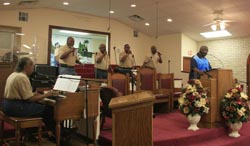
On the same fourth Sunday of the month, a gospel quartet takes center stage at a small Baptist church just up Highland Road from the Sacred Harp sing. The group of five men, wearing matching khaki polo shirts and jeans, stood behind the lectern and each held a microphone. The service begins with a cue from the organist, Leo Perkins, as the congregation gets settled into their places in the pews. The church could probably seat 100 people total and it was packed, with congregation members dressed in their Sunday best and the atmosphere excited to have the quartet singing that Sunday. "Let the church say Amen," Pastor Mack Davis requests as he quiets down the church, "Now this guy behind me on organ is ready. Let's give them the glory." This is the quartet's cue and Leo Perkins starts the organ introduction to "Lord, Hold My Hand, While I Run This Race."
The Greater St. James Men Singers has been singing as a group for nearly 11 years, but many of the members have been singing in this church much longer. In fact, their leader, Leo Perkins, has been musical director at the church for over 50 years. He directs other choirs at the church and plays organ during the service. The group came about when three members of the church's inspirational choir finally convinced Leo that they should have a quartet. As founder Donald Knighten told the story, Leo's response was always "Well, I'll look into it. Now if I go ahead and organize this group, I want you all to act right, you see?" Because I'm kind of fed up with different quartet groups." Donald said that was all they needed to prove to him they could "act right" and be a group. Finally, after a few sessions working on songs, the Greater St. James Men Singers sang at their first performance, which was the deacon of the church's anniversary. Donald explained what happened next:
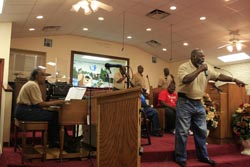
We done one song on the Deacon's anniversary and all the church liked it and wanted to know when we were going to sing again. So we told them, it wouldn't be right then because we had to rehearse some more songs. We were just doing that song to see how we was going to sound and if we sounded ok then we would try to do something else. So that's really how we got our feet on the ground and how we got rolling. We've been rolling ever since then. Back then, we added a member. He went to Beulah Baptist Church, that's around the corner from here on Port Street. And after that we got a drummer. The Lord blessed us with a drummer and his name is Benny Robinson. And our other two members are Richard Kirk and Anthony Joseph. And that's pretty much how we got started. And we're still singing for Jesus and trying to uplift his holy name as much as we can through songs and praise. (Knighten and Perkins 2016)
The group takes its inspiration from the classic gospel quartets of the mid-20th century, groups like the Swan Silvertones, the Clouds of Joy and more recent groups like the Alabama Spirituals. The songs chosen to sing are well-known to all the singers and the congregation, as evidenced by their enthusiastic response at the Sunday service. Leo even writes new repertoire for the quartet and hopes that they will be able to soon make a record of their new compositions.
On Tuesday nights, they gather at the church to rehearse their ever growing song list, which is an actual list of song titles on a piece of yellow legal paper housed in a plastic sleeve. They might go through up to six or seven songs in one rehearsal. When asked how they learn the different parts, Leo responded:
There's a song that we might do that we need to kind of find out where that part goes or where that is, or something like that. But most of these guys, we'll do strictly Gospel beats and every now and then somebody might go in the wrong part or something like that, but we don't usually have. . . . Like I've said, most of these guys have been singing choir songs. The choir and quartet parts are the same. It don't make any difference what you do. If you do choral songs or you do quartet songs, or any time you get a group together, and you teach parts. Well, the parts have got to be the same. Parts don't change, you know. That's why I'm saying quartet, it's just what you're singing. But the parts are not going to change. (Knighten and Perkins 2016)
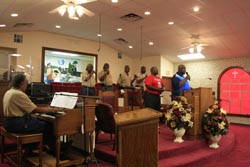
Since all the members came out of the church's other choir, they already had their part assignments and were familiar with the quartet repertoire just by being admirers of the music for most of their lives. One member, Richard Kirk, even sang in a traveling quartet called the Jerusalem Gospel Singers in the near twilight of the genre's popularity, in the late 1960s and early 1970s. They would travel within Louisiana, other nearby states and as far as Detroit and Cleveland, to do church anniversaries or shows. Those gospel show circuits still survive today and the tradition of singing for quartet anniversaries is also still strong in Baton Rouge. For the Greater Saint James Singers 2016 anniversary, they have already booked a neighboring quartet to come sing for them. And if anyone wants to book their quartet, Richard Kirk explains the process:
All somebody has to do is call him [Leo] or Donald or anybody in the group and we just get the word to the right person and go from there. If we come here, we just let each other know what it going on, like for the weekend or the next weekend, and we just get ready to show up and we go do our thing. Have a good time. That's what we call it. Having a good Gospel time. And that's what we try to do. (Knighten and Perkins 2016)



